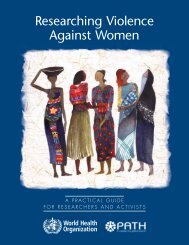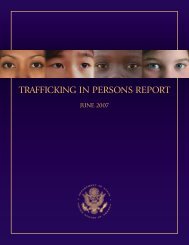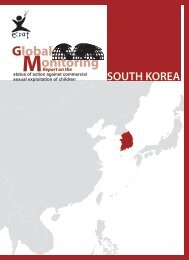Download PDF - Violence Against Children - East Asia and the ...
Download PDF - Violence Against Children - East Asia and the ...
Download PDF - Violence Against Children - East Asia and the ...
You also want an ePaper? Increase the reach of your titles
YUMPU automatically turns print PDFs into web optimized ePapers that Google loves.
Cambodia<br />
• Positive group activities involving children<br />
are seen as a counter to negative<br />
associations such as street gangs.<br />
Useful approaches to<br />
building child participation<br />
• Supporting children to work with <strong>the</strong>ir<br />
community leaders to define avenues for<br />
action that build on <strong>the</strong> increasing concerns<br />
prompted by child participation<br />
• <strong>Children</strong>’s clubs or associations developing<br />
strategies with community leaders on<br />
responses to domestic violence<br />
• Encouraging ideas <strong>and</strong> activities to emerge<br />
from children <strong>the</strong>mselves, as <strong>the</strong>ir<br />
confidence <strong>and</strong> knowledge increase; this<br />
can be assisted by encouraging critical<br />
reflection on activities or a project’s<br />
outcome<br />
• Greater linkages made between incomegenerating<br />
activities in poorer areas <strong>and</strong><br />
approaches to build child protection<br />
through participation. <strong>Children</strong> need to<br />
have opportunity to develop vocational<br />
skills; part of this process is exposure to<br />
different job roles <strong>and</strong> opportunities.<br />
Projects play a role in education on what is<br />
appropriate work, <strong>and</strong> increase links<br />
between children <strong>and</strong> local employers.<br />
• Community leaders involved in planning<br />
<strong>and</strong> supporting child participation strategies<br />
to widen <strong>the</strong>ir impact on <strong>the</strong> community<br />
• Information-sharing between children <strong>and</strong><br />
clubs, which can stimulate fur<strong>the</strong>r ideas <strong>and</strong><br />
options; in this way, children learn from<br />
each o<strong>the</strong>r <strong>and</strong> gain capacity in leadership<br />
• Projects working with children including a<br />
greater focus on communication <strong>and</strong><br />
facilitation skills to assist youth leaders to<br />
develop capacities to take increasing<br />
ownership of activities<br />
• Increased development of materials to<br />
promote learning or follow-up activities<br />
through children’s networks<br />
• NGOs nurturing <strong>and</strong> highlighting local role<br />
models in-community to encourage children.<br />
Barriers to child<br />
participation<br />
• Suspicion from community leaders or<br />
family as to <strong>the</strong> purpose of promoting<br />
opportunities for children to organise<br />
<strong>the</strong>mselves<br />
• Fear from families <strong>and</strong> leaders that children<br />
would not respect <strong>the</strong>ir elders if <strong>the</strong>y<br />
learned about rights <strong>and</strong> became less<br />
dependent on <strong>the</strong>m (respect for people<br />
older than oneself is a strong value in<br />
Cambodia). <strong>Children</strong> are at risk through<br />
being denied <strong>the</strong> right to have <strong>the</strong>ir<br />
opinions heard, as <strong>the</strong> 2001 UNICEF study<br />
Speaking Out showed, with only 17% of<br />
children responding “Yes, in my community<br />
my opinion <strong>and</strong> friends’ opinions matter”,<br />
compared to 43% in Indonesia <strong>and</strong> 73% in<br />
<strong>the</strong> Philippines. 20<br />
This barrier has been addressed through<br />
structuring projects to explore social values<br />
starting with respect for o<strong>the</strong>rs <strong>and</strong> oneself.<br />
Activities lead to children becoming more,<br />
not less, responsible. The club idea has<br />
won support in villages where it operates.<br />
• Conflicting dem<strong>and</strong>s on children, especially<br />
in families who were very poor, meant that<br />
some children’s level of accessing <strong>the</strong><br />
program was lower than hoped as <strong>the</strong>y<br />
were needed to look after cows or<br />
perform o<strong>the</strong>r roles linked to <strong>the</strong> economic<br />
fortune of <strong>the</strong> family.<br />
• Conflicting priorities within <strong>the</strong> area, such<br />
as harvest time, examinations, or natural<br />
events such as flood <strong>and</strong> drought (both of<br />
which occurred in 2002).<br />
Community participation leading to<br />
community action<br />
<strong>Children</strong>’s networks <strong>and</strong> community<br />
mobilising are significant resources in shifting<br />
attitudes <strong>and</strong> increasing local response on<br />
child protection. The CAN study 21 noted <strong>the</strong><br />
need for policies <strong>and</strong> programs that support<br />
20 UNICEF, Speaking Out: Voices of <strong>Children</strong> <strong>and</strong> Adolescents in <strong>East</strong> <strong>Asia</strong> <strong>and</strong> <strong>the</strong> Pacific: A regional opinion survey, Keen Publishing, Bangkok, 2001<br />
21<br />
Dorning K, Crying Out, World Vision International, 2002<br />
37

















